Co-Parenting Agreement
-
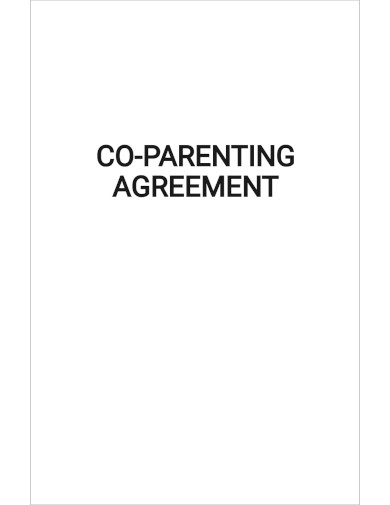
Co Parenting Agreement Template
download now -
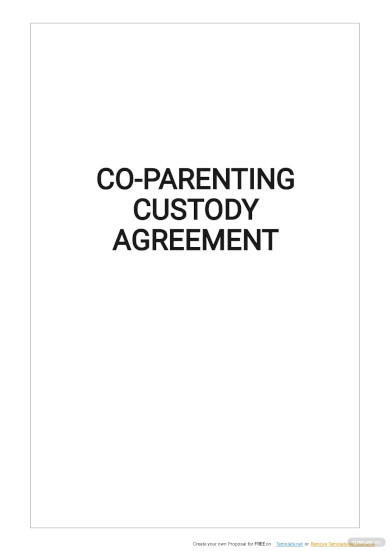
Sample Co Parenting Agreement Template
download now -
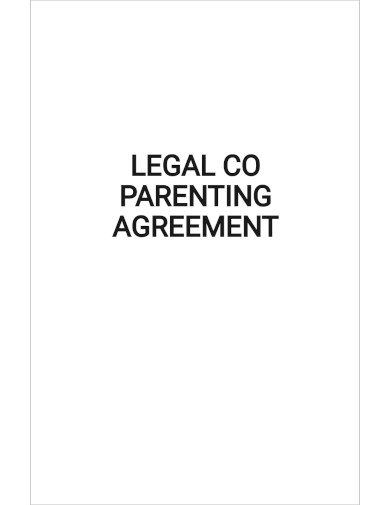
Legal Co Parenting Agreement Template
download now -
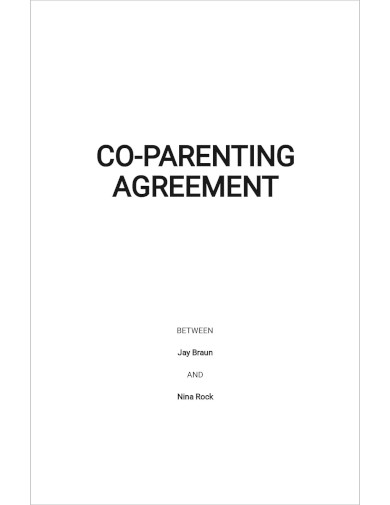
Simple Co-Parenting Agreement Template
download now -
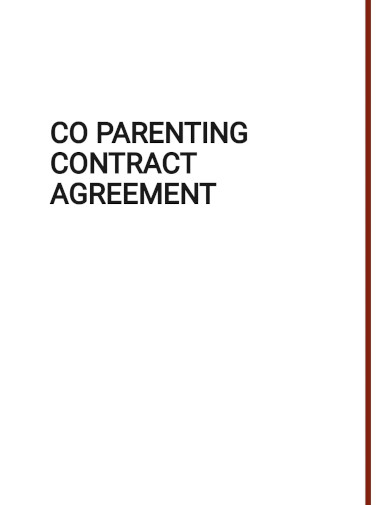
Co Parenting Contract Agreement Template
download now -

Co-Parenting Custody Agreement Template
download now -
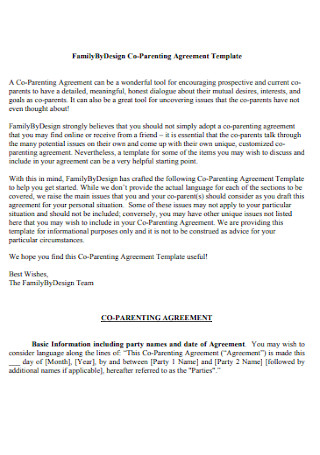
Printable Co-Parenting Agreement
download now -

Sample Co-Parenting Agreement
download now -
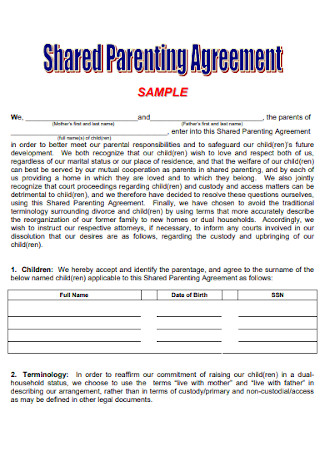
Sample Shared Child Custody Co-Parenting Agreement
download now -
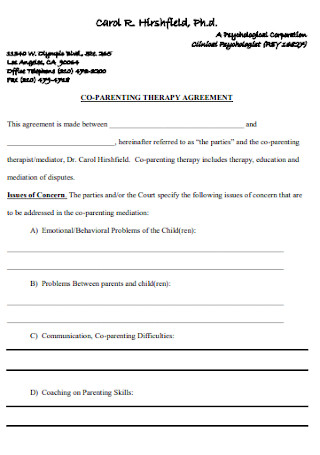
Notarized Co-Parenting Therapy Agreement
download now -
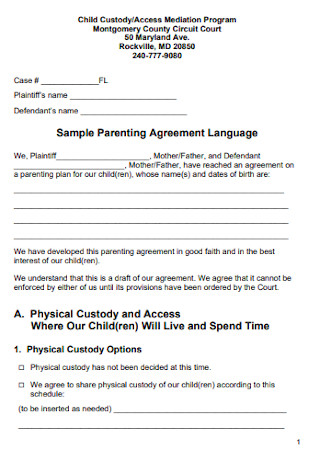
Sample Joint Custody Co-Parenting Agreement Language
download now -

Co-Parenting Sole Custody Plan Agreement
download now -

Co-Parenting Temporary Custody Counselling Agreement
download now -
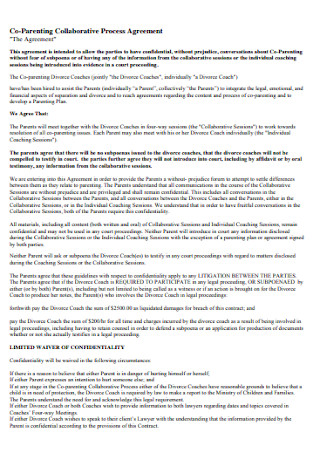
Co-Parenting Collaborative Schedule Process Agreement
download now -
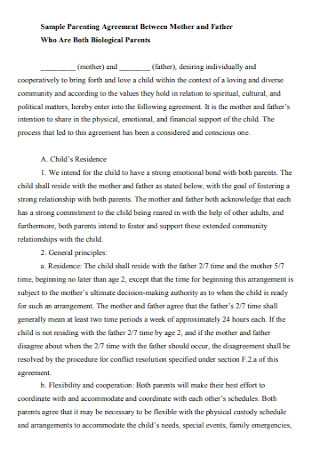
Sample Legal Parenting Agreement Between Mother and Father
download now -
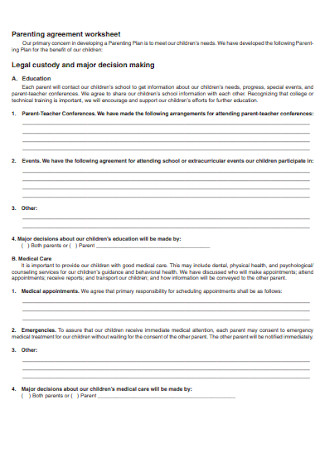
Parenting Agreement Guardianship Worksheet
download now -
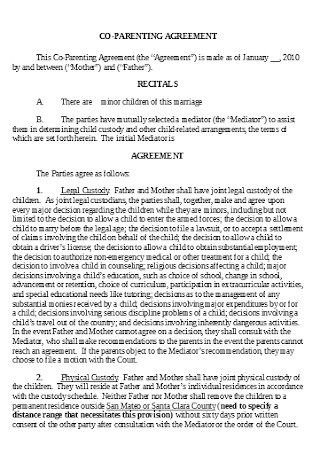
Simple Written Co-Parenting Agreement
download now
FREE Co-Parenting Agreement s to Download
Co-Parenting Agreement
What Is a Co-Parenting Agreement?
Broken Family Portraits: An Overview of the United State’s Divorce
How to Co-Parent Effectively
How to Write an Efficient Co-Parenting Agreement
FAQs
Do you need a lawyer when making a co-parenting agreement?
Can you make changes to the agreement without involving the court?
How do you differentiate co-parenting from parallel parenting?
What Is a Co-Parenting Agreement?
A co-parenting agreement, also known as a parenting plan, is a document that contains a set of guidelines and rules on how shared children will be raised after a divorce or separation. It contains responsibilities, schedules, and visitation rights, among others. This sets expectations and obligations that both parents need to fulfill upon signing the agreement. During divorce processes, some state courts might need a copy of a co-parenting agreement, but it’s legally binding unless a judge’s signature is present.
This doesn’t only apply to divorced or separated parents. Unmarried couples who don’t live together, underage parents, and parents in crisis (those suffering in mental, emotional, or physical complications) can also draft their own joint agreement to achieve the child’s best interest. Sometimes, counselors also suggest having the agreement even with two married couples who live together. For this reason, co-parenting agreements vary according to different parenting set-ups. Below are the elements of the agreement in different circumstances:
Divorced and Separated Parents
This is the most common arrangement for married couples who decided to go their separate ways but still want to get involved with their children’s lives. This situation makes the children feel the most vulnerable because they have to deal with the loss of a parent’s constant presence in the house. Drafting this agreement should highlight how both parents can manage to spend time with their children. Other elements also include:
1. Financial obligations
2. Custody
3. Visitation rights
4. Residential schedule
5. Medical aid
6. Educational support
7. Communication process
Separated Unmarried Couples
The absence of the married status makes this case a bit more complicated than divorced and separated couples. There should be an agreement even before the birth of the baby. For this arrangement, it helps when both parties are on good terms to allow them to work on the document with ease. However, when they’re on a rough patch, it’s best to make the agreement legally binding and to include every responsibility they need to perform in writing to avoid conflicts. It’s also best to include the following:
1. Details of responsibilities and the position of a parent to the child, to ensure his or her right and financial obligations.
2. Details on the legal custody
3. The child’s registered last name
4. The long-term legal process for emergencies
Parents Who Live Together
It’s uncommon to get a co-parenting agreement when both parties have not terminated their marriage and are staying in a common household. However, a written guideline so for both the husband and wife in dealing with incoming parenting issues. This might also lessen the rise of conflicts, which can foster a happier and healthier home and family relationships. For married couples, their agreement can have:
1. Responsibility assignment
2. Methods of discipline
3. Religious affiliation
4. Entertainment guidelines (TV, internet, etc.)
5. Long-term goals
Broken Family Portraits: An Overview of the United State’s Divorce
Among the historical and most controversial first divorces happened to the most notable figures of England. The case was against the kingdom’s very own king, King Henry VII, against Pope Clement VII. The king wanted to annul Catherine of Aragon when she failed to give him a son. Divorce came into the United States long before it became a nation. The earliest divorce law in the American soil can be dated as far back as 1629 in Massachusetts Bay. They created a legislative body that allowed divorce on the grounds of impotence, bigamy, desertion, adultery, and many others.
Even with the presence of divorce, it was not a popular choice among married couples. It all changed when in 1969, long before his presidency, the then Governor Ronald Reagan of California signed the no-fault divorce bill. In the next few years, every Union state heeded California’s example. Because of this, divorce rates spiked, recording a double in the statistics. By 1970, around 50% of every married couple in the country had divorced. This where the famous line “50% of marriages end in divorce was originated.
What was a rare occurrence in the past centuries became a natural scene in American society.
However, recent statistics showed a significant decrease in American divorces since 2016, which recorded 3.2 divorces out of 1,000. This is record low, compared to the 1960s to 1980s 22.6 per 1,000. The figures are expected to drop even more as the younger generation prefer to cohabit rather than get married before a certain age where they deem themselves as ready for marriage. As of 2018, 15% of people from ages 25 to 34 are living with a partner compared to 12% in 2008. Divorce might have fully integrated itself into the country, but this doesn’t keep it off the list of social problems that need proper management, especially for those who are directly affected by the struggle.
How to Co-Parent Effectively
According to the recent Statista finding, 15.76 million children (aged 18 below) live with a single mom, while 3.23 million live with a single dad in the United States. This accounts for a third of the child population in the country.
A long and fruitful marriage for every married couple might only be wishful thinking, but giving your child two present and involved parents even after a painful split is undoubtedly attainable. Read some tips on how you can build a robust co-parenting relationship down below:
How to Write an Efficient Co-Parenting Agreement
A co-parenting agreement will be your guideline for the long run. This is why couples who are in the process of divorce takes co-parenting discussion with a higher degree of seriousness because their child’s welfare is on the line. For some helpful tips, read through the steps below:
Step 1: Prioritize the Child’s Interests
When you sit to discuss what contents the agreement should have, place your child on top of the agenda Shot List. Talk about how you can adequately supply his needs in separate households. In physical aspects, you need to consider his food, shelter, clothing, and medical support. You might also want to tackle how to enrich his development through educational support and other extracurricular activities that he takes an interest in. Do not neglect his need for attention and support to boost his emotional stability, especially with the complication of the separation. For this, you might want to consider how far you’ll be away from each other and if you’ll be present when he needs you to be.
Step 2: Agree on a Schedule
The parenting schedule will mean a huge deal on how you’re going to shape your new arrangement. This is also significant to your child because it’s the first thing he’ll need to get used to. Pick a routine that works best for your family. A 50/50 arrangement, such as every two-week stay with the other parent, might work for families who live nearby. However, the constant toll might cause discomfort to the child. Weekend visitations and twice-a-month visits can work out great. For those who live in a far state, summer and winter breaks are a good schedule to make every year. You also need to be flexible for special occasions such as school recitals and birthday parties. The goal of the schedule is not to lose the relationship of a parent to the child, and it should be plotted in a manner that will fulfill that objective.
Step 3: Compromise, Compromise, Compromise
During the planning stage of your agreement, you might have the urge to put in conditions that favors you greatly over your partner. More than being unfair, this doesn’t benefit your child. The agreement should be rooted in your child’s needs, and pitching in self-serving ideas will only result in an added conflict. Whenever your decision ends up at an intersection, mull over what needs to be sacrificed and who needs to make way for the completion of your agreement. And the compromise doesn’t end when you’ve both signed the end of the paper. This goes on and on as you tend to your child’s concerns. There might be situations where you need to assume your former partner’s responsibilities due to certain circumstances.
Step 4: Be Clear on the Decision-Making Process
Being a parent also means being able to have the deciding power over your child’s welfare. That power is split in half when a pair parts ways. Decision rights can be a huge issue as you go along the co-parenting process through the ways and will not be in any way beneficial. Matters on education, cultural influences, health, religion, and discipline can significantly shape a child’s life. The parenting plan must include how these decisions should be made.
Step 5: Keep the Communication Lines Open
Co-parenting a child with an ex-spouse who never communicates with you dooms the agreement to failure. Even when both decide to enter a brand new marriage, active communication is highly necessary. This way, you’ll be able to discuss your child’s needs and how you can make better decisions on his behalf. A civil partnership makes it easier for the child to adjust to the changes brought by the separation. You can organize a system where you’ll be able to keep updates of the parenting schedule as well as appointments and activities where your presence is required. This is how you’ll also be able to keep updates of your child’s progress and concerns.
FAQs
Do you need a lawyer when making a co-parenting agreement?
While it’s necessary, you might need the help of a lawyer when drafting your co-parenting agreement in some circumstances. Even if you don’t, consulting a lawyer is highly recommended to ensure that every part of the deal fits your child’s needs and works effectively for both parties.
Can you make changes to the agreement without involving the court?
Yes, as long as both co-parents agree with the changes.
How do you differentiate co-parenting from parallel parenting?
While co-parenting is where two partners look after a child even after separation, parallel parenting follows the same rule, except that the separated partner cannot interact with each other. Co-parents can communicate with each other and attend their child’s appointment at the same time, but this is impossible for parallel parents.
Separation continues to be among the heartbreaks of every family around the world. A failed marriage and a looming split up might be among any couple’s nightmares, but it takes a greater toll on the child. Especially when they’re at the age when they’re unaware of divorce customs and how their parent’s arrangement changes overnight. An efficient co-parenting method allows the child to be more understanding of the situation and transition into the new arrangement with ease and comfort, knowing that both of his parents are involved and concerned for his well-being.
